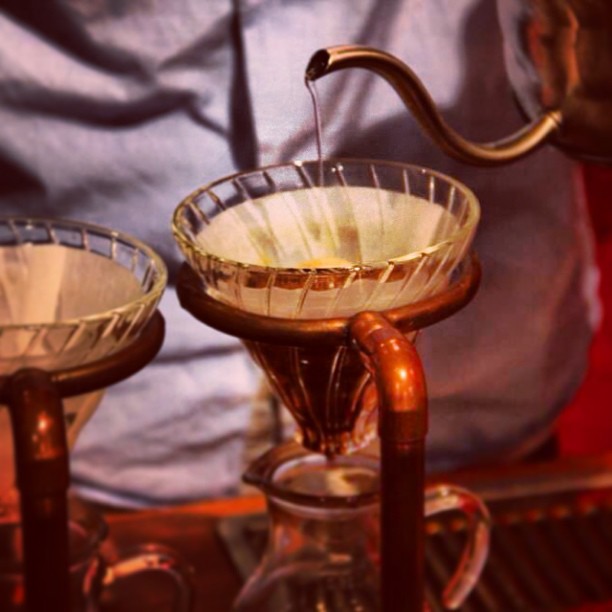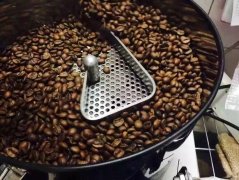Coffee production in Vietnam Coffee processing in Vietnam

I. Coffee production in Vietnam
Vietnam's geographical location is very favorable for coffee cultivation. Southern Vietnam has a hot and humid tropical climate, which is suitable for growing ROBUSTA coffee, while the north is suitable for growing ARABICA coffee. Coffee production in Vietnam has the following characteristics: (1) because there is no effective way to deal with fallen leaves, medium-grain coffee was selected as the main variety in the early 1980s. (2) based on the planting technology, the coffee planting method was determined, that is, under the hot and humid climate in southern Vietnam, high density planting, large amount of irrigation, excessive fertilization and no shading trees were used to obtain the maximum yield and give full play to the production capacity of medium-grain coffee. The per unit yield of many coffee plantations in Daklak, Gia Lai, Kontum and Dong Nai areas of Vietnam reached 340t / ha. The yield of some plantations is even as high as 89.9 tons per hectare. (3) processing technology: mainly making full use of the solar energy drying method in the dry season in the plateau of central Vietnam to process coffee.
Coffee cultivation in Vietnam covers an area of about 500000 hectares, of which 10% are owned by state-owned enterprises and farms, and 85% by farmers and landowners. The scale of the manor is small, usually 2-5 hectares, and the large manor is about 30-50 hectares, but the number is small. Vietnamese coffee ranks second in all agricultural products exported from Vietnam, second only to rice. Every year, about 300000 farmers are engaged in coffee cultivation, with a labor force of 600000, and the labor force can reach 700000 to 800000 in the three-month harvest period. as a result, the coffee industry has absorbed 1.83% of the country's total labor force and 2.93% of the total agricultural labor force.
Vietnam Coffee Corporation (VINACAFE) is a 100% state-owned enterprise with 70 companies and farms under its jurisdiction. VINACAFE exports 20-25% of Vietnam's coffee production each year.
According to the business statistics of Vietnam Coffee Association, in 2000-2001 (from October 2000 to September 2001), a total of 874676 tons of coffee were exported from 149 units in Vietnam, of which the three largest export companies were OLAM (wholly foreign-owned enterprise, 21326 tons), DAKMAN (joint venture, 18076 tons) and VINAFIMEX (local enterprises, 13719 tons).
The Vietnam Coffee quality Standards Committee was led by the Vietnam Coffee Association to draft the Vietnam National Coffee Standard, which was reported to the Ministry of Science, Technology and Environment (now the Ministry of Science and Technology) for examination and approval.
II. Coffee processing in Vietnam
In the field of coffee processing, there have been some dilapidated processing plants since 1975, and there are several processing plants in northern Tongjiao, Fukui and other places, whose equipment was made in East Germany from 1960 to 1962. In the south, the old factories left by former landowners such as ROSSI,DELPHANTE are also small. While expanding the coffee planting area, Yue also began to build new coffee processing plants, first producing some stand-alone equipment, and later imitating the production line according to the HANGXA style, the main manufacturers are the Haiphong May 1 Machinery Factory, the Ministry of Industry A74 Plant in Shoude, Ho Chi Minh City, and so on. In recent years, many companies and farms in Vietnam have imported new processing plants with relatively complete equipment from Germany and Brazil, and imported more than a dozen sets of coffee processing production lines from PINHALENSE of Brazil. Since then, more and more factories began to imitate and improve their own production of Brazilian equipment. In recent years, the processing capacity of Vietnamese coffee has been greatly improved, which can guarantee the export of 150000 to 200000 tons of coffee kernels per year. In addition, there are many enterprises with inadequate equipment, which only rely on a few stand-alone machines for processing, and purchase newly processed coffee from farmers to ensure export standards. The coffee purchased from the private sector is mainly handled by each farmer through the cement yard or soil yard. Farmers in many places use small grinders to grind dried coffee fruits into coffee kernels and sell them to coffee buyers. This kind of processing leads to the instability of product quality. Coffee produced by companies and farms is usually of good quality and beautiful appearance, such as thang loi, phuoc an, viet duc, buon ho, d'dao and so on, which are recognized by customers. Generally speaking, the sale of coffee has not been carried out in accordance with national standards for a long time, and the quality provisions in the sale and purchase contract are very simple, which are only determined through consultation between the buyer and the seller, which can not effectively promote the improvement of coffee quality and the level of the processing industry.
In recent years, the above situation has improved. As the supply exceeds demand, the price of coffee continues to fall, causing the buyer to demand higher quality and to increase the requirements to the seller, such as the general request to try the sample, which is used as a basis for settlement and payment. The coffee industry in Vietnam must improve its processing level in time. In addition to customers demanding higher quality standards, the Vietnamese coffee industry also faces problems in the world coffee market:
The Association of Coffee producing countries (ACPC) supports some Chinese and American coffee producing countries on eliminating low-quality coffee from the world coffee market in order to stabilize the balance of supply and demand in the market.
Since January 1, 2003, EU countries have applied OCHRATOXYN A pollution targets and destroyed substandard coffee on a large scale.
The above requirements of Vietnamese coffee need to be greatly improved in the field of processing in order to continue to adapt and develop.
At present, Vietnamese coffee is still mainly dry-processed ROBUSTA, coffee purchased back to use solar energy to dry. If there is continuous overcast and rainy weather during the harvest season, burn coal or firewood to dry. There are also some enterprises that use blenders for wet processing. The ARABICA with small output is processed completely by wet process. SORTEX color sorter is used for classification in many places.
III. Development Plan of Coffee Industry in Vietnam
At present, Vietnam is making strategic adjustments according to the following main contents:
1. Change the planting structure and determine the strategic goal of the development of the industry. Reduce the planting area of ROBUSTA coffee and turn the land with low efficiency in coffee cultivation into other perennial cash crops such as rubber, pepper, fruit trees and annual crops such as cotton and hybrid corn.
Expand the planting area of ARABICA coffee in areas where conditions permit. The ultimate goal of the strategy is to maintain or slightly reduce the current perennial area of coffee to about 450000 to 500000 hectares, including 350000 to 400000 hectares for ROBUSTA coffee (a decrease of 100000 to 150000 hectares) and 100000 hectares for ARABICA coffee (an increase of 60, 000 hectares over the 40, 000 hectares previously grown with French aid loans). The total output is guaranteed to be about 600000 tons, equivalent to 10 million packets, 5 million packets less than the current ROBUSTA coffee.
2. Reduce the production cost and improve the operation efficiency. Although the labor cost of Vietnamese coffee industry is relatively low and the output of coffee is high, the cost of Vietnamese coffee is still high and it is difficult to be competitive. The main reason is that Vietnamese farmers purchase a large number of chemical fertilizers and irrigation in order to increase their output as much as possible, which reduces the efficiency of investment and increases the cost of production. Therefore, it is necessary to adjust the investment structure and reduce the investment in chemical fertilizers, pesticides and irrigation. It is not necessary to pursue the highest output but can achieve the most considerable profit level. In addition, at present, Yue farmers use a large number of chemical fertilizers, which should be replaced by organic fertilizers to improve the scientific and technological content.
3. Improve the processing technology and equipment, adopt the Vietnamese national product quality standard in line with the international standards, and improve the product quality according to the market requirements. Now, the ability to process ARABICA coffee is poor, especially in the first process of peeling. Due to the lack of a large amount of clean water and sewage treatment facilities in many areas, it is inevitable to pollute the environment.
4. Produce and provide a variety of goods except raw coffee kernels to the market to meet the needs of consumers. At present, there are two instant coffee manufacturers, one is the Bianhe coffee factory under VINACAFE, and the other is the Vietnam factory of Nestl é (Thailand). The current problem is to expand the market scope. In addition, the development of boxed liquid coffee is also being considered.
5. Produce high quality products, such as organic coffee, special coffee and so on. The climatic conditions in the mountains of northern Vietnam are suitable, which is conducive to the growth of ARABICA. Local minorities seldom use chemical fertilizers and pesticides, and have the conditions to develop organic coffee, but the problem is that organic coffee requires authoritative certificates and market recognition, and the more areas do not reach this level.
6. reform the business relationship, strengthen the development of the international market of Vietnamese coffee, and pay more attention to the development of the domestic market. At present, Vietnamese coffee has been exported to 50 countries and regions in the world, but it lacks traditional and stable trading partners. Yue Coffee has not yet participated in futures market trading. At the same time, the domestic coffee market in Vietnam has not been fully developed, and although Vietnamese have been drinking tea for a long time, the potential for young people to drink coffee is considerable.
7. The last thing is to maintain the stable development of the coffee industry in Vietnam. The coffee industry in Vietnam supports 600000 farmers, and the number of people related to the industry reaches 1 million. The coffee industry in Vietnam is still weak, and it is still very weak compared with the world's traditional coffee powers. Therefore, it is necessary to take advanced measures in coffee cultivation, production, processing and trade to improve efficiency and develop Vietnam's coffee industry into a stable and sustainable industry.
(source: website of the Ministry of Commerce)
Important Notice :
前街咖啡 FrontStreet Coffee has moved to new addredd:
FrontStreet Coffee Address: 315,Donghua East Road,GuangZhou
Tel:020 38364473
- Prev

The Origin of Vietnamese Coffee the characteristics of Vietnamese coffee
Drinking coffee is a daily habit of Vietnamese. Vietnamese cafes are very common, not high-spending places, and ordinary ones are only a few yuan RMB. Vietnamese coffee is not brewed in a coffee pot, but a special dripping coffee cup, followed by an old-fashioned printed glass, drop by drop to pass the time. When making, there is a dripping cup on the cup holder below.
- Next

Why is Vietnamese coffee famous? The characteristics of Vietnamese Coffee
A brief introduction to the Central Plains G7 instant coffee will take you to enjoy the fragrant and mellow coffee taste of Bang Mei Department of Vietnam! The excellent quality of Central Plains products, the variety of Central Plains G7 coffee, strong production capacity and abundant supply of raw materials (Zhongyuan's own coffee plantation) have all become a strong guarantee for Zhongyuan Company to seize the city. in addition to occupying the domestic market, its coffee products
Related
- Detailed explanation of Jadeite planting Land in Panamanian Jadeite Manor introduction to the grading system of Jadeite competitive bidding, Red bid, Green bid and Rose Summer
- Story of Coffee planting in Brenka region of Costa Rica Stonehenge Manor anaerobic heavy honey treatment of flavor mouth
- What's on the barrel of Blue Mountain Coffee beans?
- Can American coffee also pull flowers? How to use hot American style to pull out a good-looking pattern?
- Can you make a cold extract with coffee beans? What is the right proportion for cold-extracted coffee formula?
- Indonesian PWN Gold Mandrine Coffee Origin Features Flavor How to Chong? Mandolin coffee is American.
- A brief introduction to the flavor characteristics of Brazilian yellow bourbon coffee beans
- What is the effect of different water quality on the flavor of cold-extracted coffee? What kind of water is best for brewing coffee?
- Why do you think of Rose Summer whenever you mention Panamanian coffee?
- Introduction to the characteristics of authentic blue mountain coffee bean producing areas? What is the CIB Coffee Authority in Jamaica?

